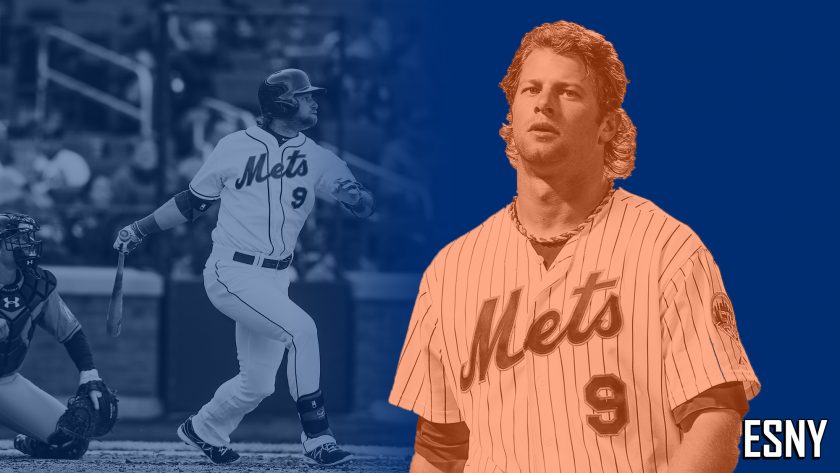Remember the New York Met: Outfielder Kirk Nieuwenhuis

Remembering former New York Mets outfielder Kirk Nieuwenhuis, who portrayed his talents in Queens for much of his short-lived career.
Around here, New York Mets fans get their hopes up more often than the F train breaks down. We’re like dogs barking at the doorbell or bulls chasing a red cape. It’s just what we do.
It usually falls apart and comes to nothing, but so what? That never bothered a dog or a bull. We pick ourselves up, and when something good comes around again, hopes fly higher than the seagulls over Flushing Bay. Nonetheless, this time is different. This time there really is an intruder. This time, that matador is toast.
So in March and April 2012, when Kirk Nieuwenhuis made 19 starts and batted .325/.386/.475, hopes were higher than high. They were astronomical.
Nieuwenhuis, a 24-year-old outfielder, was a third-round pick in 2008. He was a former high school football player, and he looked like it. Six-foot-three, 225 pounds, essentially a linebacker in an outfielder’s uniform. He was a California kid with curled golden hair, resolve in his eyes, and a sweet lefthanded swing.
He advanced through the Mets farm system, and after he put up a .908 OPS for Triple-A Buffalo in 2011, it was obvious that he was ready. Sure enough, when Andres Torres aggravated his calf injury on Opening Day in 2012, Nieuwenhuis received the call.
In his first game, he batted eighth and recorded two hits, as the Mets defeated the Atlanta Braves. Two days later, he hit his first career home run against the Washington Nationals.
Around then, Rookie of the Year chatter started to build.
Well, not really, but a little bit. Mets fans can’t resist a young star. The 2012 season wasn’t like the last six years when most of the young players to debut for this ballclub have satisfied expectations. Pete Alonso, Brandon Nimmo, Michael Conforto, Jacob deGrom, Noah Syndergaard, Steven Matz, Seth Lugo, J.D. Davis…it doesn’t always happen.
No. Back then, conversations were different.
“Nick Evans is going to be a star.”
“Fernando Martinez is the real deal.”
“Josh Thole can really hit.”
“Jordany Valdespin is a dynamic player.”
Then Nieuwenhuis came around and started hitting like…well, a hitter. By April 18, he was in the leadoff spot. That day, he went 3-for-4. He was batting .375.
Mets fans knew his name. It wasn’t an easy name to know, but they knew it. “New-in-hice.” Captain Kirk. The legend began.
A week later, the legend grew. The Marlins were in town and José Reyes was coming back to Citi Field for the first time. Over nine seasons in Queens, Reyes had built up a portfolio of goodwill from Mets fans — then he squandered it faster than Pete Rose in Las Vegas. First, he took himself out of his last game with the Mets in the first inning. Then, he signed with the division rival.
The Mets won the first two games of the series. But on April 26, while going for the sweep, they fell behind 2-1. The Marlins led in the bottom of the ninth inning, as Heath Bell came in to close.
Bell didn’t seem interested in winning. He walked four of the first six batters he faced, and the Mets tied the game. Nieuwenhuis then came up to bat with two outs.
Bell pitched. Nieuwenhuis swung. The ball flew and landed on the warning track, leading to a Mets victory. Nieuwenhuis rounded first and his teammates mobbed him.
He was an icon and superstar, floating on a cloud of adoration. He was going to win National League Rookie of the Year and was probably going to be in the running for the National League MVP Award as well.
That, more or less, was the high point of the legend of Nieuwenhuis. His impending regression was obvious: no one noticed because no one wanted to look. In April, Nieuwenhuis’ BABIP was .453. After April, he batted .223/.283/.337. On July 28, he was optioned back to the minors. A little over a week later, he tore his plantar fascia running to first and was done for the season.
The legend had ended. But Nieuwenhuis was still there. In 2015, the Mets traded him to the Los Angeles Angels but brought him back less than a month later. They called him up from Las Vegas on July 6. On July 12, he hit three home runs against the Arizona Diamondbacks, the first player ever to do so at Citi Field.
On Sept. 8, protecting their first-place lead against the Nationals, the Mets were behind 7-1 in the seventh inning. But then, with two outs, they scored six runs to tie the game.
The Nationals brought in closer Jonathan Papelbon in the eighth inning. With two outs, Nieuwenhuis came up to bat. He hit Papelbon’s second pitch over the right field fence. It was the death knell of Washington’s season. The Mets were going to the playoffs.
Sometimes there really is an intruder at the door. The matador becomes cocky, and the bull isn’t done yet.
I have followed New York sports passionately for almost my entire life, since I went to Shea Stadium in 2004 and saw Jae Seo lose 8-1 to the Pirates. At journalism school, I once missed covering a Land Use Committee meeting to write about Jacob deGrom's last start of the year.






